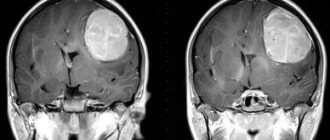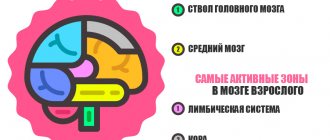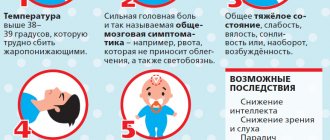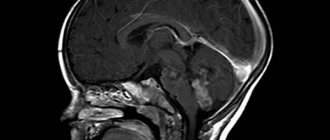What is cerebral ischemia?
Cerebral ischemia is a disease that develops due to a lack of oxygen necessary for brain function. It can be congenital and chronic. The first form occurs in young children. Chronic cerebral ischemia is typical for people in old age.
Hypoxia occurs when blood clots or atherosclerotic plaques form in the vessels that provide access to oxygen and nutrients to the brain. This process is accompanied by a change in blood pressure in large arterial trunks and arterioles. If it increases sharply, the vascular walls are destroyed and saturated with plasma proteins. This leads to the proliferation of connective tissue. It fills the lumen of the vessel, causing it to narrow. Blood circulation becomes difficult. A complete blockage prevents blood from delivering oxygen and nutrients to brain cells. This is fatal.
Causes of the disease
Arterial hypertension and atherosclerosis (often a combination of both) are one of the main provocateurs of the pathological process. Pathologies such as:
- heart and vascular diseases - accompanied by heart failure, arrhythmia;
- vascular anomalies of the aortic arch, cervical and brachial regions, and head brain;
- venous diseases - extra- and intracranial, with compression of veins, vessels, arteries and tissue compression (tumors, aneurysms);
- cerebral amyloidosis - applies to elderly patients.
The etiology of cerebral ischemia is mainly mixed. This is a dominant factor (hypertension or atherosclerosis) and many other causes, interpreted as additional provocateurs that significantly aggravate the course of the disease.
According to pathogenetics, encephalopathy is divided, according to morphological characteristics, into 2 types:
- Discirculatory - bilateral foci of diffusion.
- Lacunar - multiple lesions of the white matter.
It is not uncommon to diagnose a mixed version of ischemic lesions.
Symptoms of cerebral ischemia
The first signals indicating cerebral ischemia are rapid fatigue during mental work and forgetfulness. Older people often do not consider this a sign of a serious illness, given their age. But if your memory suddenly deteriorates, you should consult a doctor. Patients with cerebral ischemia suffer from constant headaches.
As the disease progresses, falls, fainting, and dizziness are possible. There is a sharp increase in blood pressure, nausea, turning into vomiting. In the later stages of cerebral ischemia, vision and hearing are impaired. The patient is not capable of work, mental activity, or self-care. He loses sleep, cannot make complex movements, and suffers from unsteadiness when walking.
An acute form of cerebral ischemia is a stroke. It is focal in nature and occurs when a plaque inside a vessel ruptures and blocks the lumen. As a result of thrombosis, blood stops flowing to the brain, which is why tissue necrosis, that is, ischemic stroke, is inevitable. After it, deep neurological disorders occur: sensitivity and the ability to move independently may disappear.
Diagnosis of cerebral ischemia is carried out by visible symptoms, as well as on the basis of studies of cerebral and sensory function. A survey is conducted of the patient and his relatives, since patients in the later stages of the disease often suffer from dementia and memory loss. Magnetic resonance imaging and computed tomography are necessary to examine the cerebral cortex. The results of the procedures allow the doctor to see the changes that have occurred in her.
Diagnostic examination
A history of cerebral ischemia usually includes pathologies such as myocardial infarction, cardiac ischemia, arterial hypertension, diabetes, etc. At the stage of physical examination, possible causes of CVS pathology that trigger the process of cerebrovascular insufficiency are identified. The following manipulations are carried out:
- blood pressure measurements in all extremities;
- determination of heart rate using auscultation;
- checking pulsation for integrity and symmetry in the head and limbs.
Laboratory diagnostics are aimed at identifying the factors that caused and triggered ischemic processes in the brain. The patient is prescribed:
- blood test (general, sugar, lipids);
- instrumental examination (ECG, ECHO, duplex/triplex scanning, etc.).
For correct diagnosis, it is important to distinguish encephalopathy from other neurodegenerative conditions that are characterized by cognitive and neurological disorders.
Causes of cerebral ischemia
Atherosclerosis
This disease is considered chronic and affects large blood vessels in the body. Cholesterol deposits accumulate on their walls, forming atherosclerotic plaques. They are capable of increasing in size and can either significantly reduce blood flow or close the lumen of the vessel completely. Atherosclerosis affects mainly men.
Its development is promoted by poor diet, smoking, obesity, frequent stress and diabetes. Treatment of atherosclerosis requires not only taking medications, but also moderate physical activity and diet. Foods containing cholesterol and fats should be excluded from the diet.
It is they that cause blockage of blood vessels, depositing in the form of atherosclerotic plaques. Blood moving through arteries can carry particles of such tumors. They get stuck in narrow parts of the vessel and stop blood circulation.
Patients with atherosclerosis are advised to avoid fried and fatty foods, red meat, and alcohol. It is recommended to eat wholemeal bread, cereals, and foods containing Omega-3 fatty acids. It is important to maintain a normal weight, since obesity is one of the risk factors for atherosclerosis.
Arterial hypertension
This is the medical term for increased blood pressure. This disease cannot be completely cured. However, it is necessary to constantly keep blood pressure under control to prevent various complications, including cerebral ischemia.
As with atherosclerosis, arterial hypertension affects men more often. Risk factors also include old age, a lot of stress, bad habits and obesity.
An increase in blood pressure may not be accompanied by visible external signs or changes in the patient’s well-being. It can be determined using a tonometer. Sometimes a sharp increase in blood pressure is accompanied by dizziness and headaches. Some patients note the appearance of red dots before their eyes.
To prevent a sharp increase in blood pressure, you need to do exercises daily, reduce the consumption of salt, processed foods, and sweets. If you have excess weight, you should get rid of it. The diet must include foods rich in potassium. It is important to visit your doctor regularly and monitor your blood pressure levels.
Cerebral vasculitis
The disease is non-infectious in nature and manifests itself in the form of inflammation of the blood vessels. This causes their narrowing and the development of coronary disease. The exact causes of vasculitis are not known; it can occur at any age. Manifested by severe headaches, leg cramps, hearing or vision impairment. In the early stages of development, vasculitis can be confused with tumor diseases. It progresses quickly, and it is very difficult to cope with, largely due to difficulties in diagnosis. A biopsy can accurately determine the presence of this disease, but it is most often impossible due to the threat of hemorrhage.
The causes of cerebral ischemia include pathologies, vascular anomalies, and rheumatism, but they are of secondary importance. Patients with diabetes and the elderly are at risk. Smoking provokes the formation of plaques in blood vessels, since cigarette smoke contains carbon monoxide and nicotine. Tachycardia, bradycardia, acute heart failure, increased blood viscosity caused by erythrocytosis or anemia - all this also contributes to the development of cerebral ischemia in adults.
Treatment of chronic cerebrovascular insufficiency
The meaning of therapeutic measures is to stabilize/stop the destruction of brain cells, stop/slow down the rate of progress and prevent stroke. The latter is an indication for urgent hospitalization, as is the development of complex somatic disorders. In other cases, cerebral ischemia is treated on an outpatient basis, under the supervision of a neurologist. On the contrary, depriving the patient of a familiar environment during treatment can cause a worsening of the condition. Patronage is assigned to patients at the 3rd stage of encephalopathy.
Treatment includes several areas:
- medication - to normalize the functioning of the cardiovascular system and optimize the blood supply to the intracranial brain;
- hypotensive - to normalize and maintain blood pressure, regulate the mechanism of blood flow, which can cause damage to target organs;
- hypolipidemic - for patients with dyslipidemia and atherosclerosis (diet without animal fats and lipid-lowering drugs);
- antiplatelet - to activate hemostasis processes;
- combo drugs - to normalize blood functions and improve venous outflow.
Chronic cerebral ischemia may be an indication for surgery if the main blood arteries are affected.
Degrees of cerebral ischemia
Cerebral ischemia grade 1
At this stage, the symptoms of the disease are mild. The patient suffers from headaches, heaviness in the head, gets tired quickly and experiences general weakness. Sleep is disturbed, problems with hearing, vision and memory are possible. The disorders are stable, but the formation of syndromes has not yet occurred. This allows you to reduce the symptoms or eliminate them completely, as well as the disease as a whole. The changes concern the patient’s psychological state: emotional lability is possible, that is, a rapid change of mood for no reason.
Cerebral ischemia grade 2
Asthenic symptoms are less common. Stage 2 of cerebral ischemia is characterized by loss of memory and ability to work. The patient experiences constant weakness, dizziness, and may have difficulty performing the simplest movements, for example, walking. Vision problems appear, oral automatism reflexes are disrupted, and convulsions occur. The duration of the periods during which disturbances appear increases.
Pathological reflexes are reflected in intellectual-mnestic disorders. This means that mental work becomes impossible for the patient. As with grade 1 cerebral ischemia, the patient experiences psychological difficulties and emotional lability progresses.
Cerebral ischemia grade 3
At this stage, organic brain damage is observed. Patients often faint and are unable to perform simple actions on their own, so they need help. Circulatory disorders manifest themselves in the form of “small strokes” or a progressive “complete stroke”. At stage 3 of cerebral ischemia, dementia, that is, dementia, is possible.
Patients' cognitive ability decreases, they can no longer carry out full intellectual activity. In addition, patients experience memory problems. This causes a sharp decline in their quality of life and social adaptation. Violation of gnosis and praxis, which are one of the main functions of the brain, leads to the inability to navigate in space, recognize familiar objects and perform complex motor acts.
Cerebral ischemia in prematurity and in full-term infants
At term and at prematurity, the nature of brain damage is different. If a baby is not carried to term for 9 months, he or she is at risk of periventricular leukomalacia (PVL). This means that the white matter of the brain, located near the ventricles, dies and cysts form there.
PVL causes dementia and cerebral palsy in those born before the 31st week of gestation.
And for those who spent the entire period in the mother’s belly, damage mainly occurs to the cerebral cortex, that is, to the gray matter. The consequences for the child will depend on where the necrotic zone is located and how large it is. In acute and severe asphyxia (suffocation), damage to the brain stem is likely. Therefore, the child will have problems with heartbeat and breathing, which in some cases causes death, that is, death.
Cerebral ischemia in newborns
Congenital cerebral ischemia in children develops due to hypoxia during childbirth or pregnancy. The risk of oxygen deficiency increases with the age of the mother. In young girls, the risk of cerebral ischemia in children is slightly lower than in women after 30.
However, this factor is not decisive. An important role is played by the presence of various diseases in the mother, for example, diabetes mellitus, and taking various medications during pregnancy. The development of cerebral ischemia can be prevented by the competent work of doctors during childbirth, when there is a danger of lack of oxygen.
Depending on the degree of the disease, various symptoms are distinguished. In the early stages, cerebral ischemia manifests itself in the form of increased depression or excitation of the child. Grade 1, which is considered the mildest, is diagnosed most often. As a rule, the disease goes away some time after birth. Cerebral ischemia grade 2 is characterized by more serious brain damage.
Loss of appetite and frequent mood swings may also be a reason to contact a neurologist. The child has dystonia, impaired psychomotor and speech development, and motor activity. For example, he may stand on his toes when walking. At stage 3 of cerebral ischemia, hospitalization of a small patient is necessary.
Symptoms
Due to the fact that oxygen starvation of the brain and spinal cord can vary in severity and duration, cerebral ischemia that occurs as a result also manifests itself more or less clearly.
Thus, grade 1 cerebral ischemia is considered the mildest and is limited to subtle motor abnormalities in the first year or two of life. Cerebral ischemia of the 2nd degree requires more serious and long-term treatment, since without it it can affect the child with the appearance of motor disorders, speech retardation and decreased intelligence. As for cerebral ischemia of the 3rd degree, it is close in meaning to asphyxia (suffocation) of the fetus, and sometimes even leads to death.
Mild impairments
Most often, with cerebral ischemia of the first degree, such signs are observed.
- Increased excitability. In the form of trembling of the limbs, tension of individual muscles, acute reaction to sudden noise, bright light. A child with such symptoms of cerebral ischemia is often irritated and cries, sleeps poorly, but his appetite is preserved and even higher than normal.
- Reduced excitability. The opposite state of depression, in which the baby is lethargic and reluctant to move, sleeps a lot and deeply, and has difficulty sucking the breast and swallowing milk.
- Motor disorders. The most common of them in cerebral ischemia is an incorrect reflex turn of the feet (outward or inward, as with clubfoot). They can also manifest themselves as involuntary “lifting on tiptoes” when someone takes the child under the armpits.
Moderate severity
Cerebral ischemia of the second degree can also manifest itself in different ways, but the symptoms are the most typical for it.
- Asymmetry. Faces, body positions, limb movements. The reason for all its manifestations in cerebral ischemia is the same - the difference in the tone and motor activity of the same muscles/muscle groups located in different halves of the body. The phenomenon in which the baby smiles only on the right or left half of his face or, for example, one of his shoulders hangs clearly more than the other, is considered a bad sign. It is more difficult to equalize the “dissonance” of the halves of the body that arises as a result of cerebral ischemia than a uniform lag in the development of both hemispheres of the brain. Plus, such symptoms in children, as in adults, often “hint” at a stroke, which arose as a complication of a sharp drop in pressure.
- Strabismus. “Divergence” of the eyeballs in different directions or their classic bevel in one direction. This defect is often associated with impaired motility of the eye muscles, in particular, due to improper control of them by the cerebral cortex. It can also occur due to abnormalities in the structure of the eye and vision defects. Therefore, strabismus itself is not a strict diagnostic sign of cerebral ischemia - other symptoms and, most importantly, risk factors are needed.
- Tendency to seizures. In the form of involuntary shuddering of the limbs or torso, unmotivated single or serial spasms throughout the body.
Expressed symptoms
The third degree of cerebral ischemia is characterized by any of the above symptoms in combination with severe neurological disorders.
- Paresis. Constant disturbances in the amplitude and strength of movements, which are especially noticeable in children suffering from cerebral palsy (CP).
- Hydrocephalus. Accumulation of cerebrospinal fluid in the ventricles of the brain, which leads to an enlargement of the skull, bulging and pulsation of the fontanelles. Hydrocephalus as a result of cerebral ischemia is prone to chronicity, and over time leads to partial replacement of the brain substance with huge ventricles filled with only cerebrospinal fluid.
- Impaired coordination of movements. It often looks like pointless physical activity.
- Coma. Occurs with cerebral ischemia in children due to a rapid increase in intracranial pressure.
A decrease or increase in excitability and tone of all muscles is often accompanied by changes in body temperature during cerebral ischemia in newborns. An overexcited child often also has an elevated temperature. Such changes in the functioning of the entire thermoregulation system are especially characteristic of the acute period of cerebral ischemia in children, which lasts, on average, five to seven days after birth.
Treatment of cerebral ischemia in a newborn
Vascular obstruction (occlusion): types, symptoms, treatment
Cerebral vascular ischemia can have different effects on the newborn’s body. This depends on the degree of detected pathology. It is based on this and what symptoms are observed in the newborn that treatment will be prescribed.
The disease leads to damage to certain areas of the brain, so therapy should begin immediately after diagnosis. Despite the rapid development of modern medicine, it is impossible to restore tissue that has already died. Timely and competent treatment makes it possible to stop the progression of the disease, preventing it from becoming severe. In order for the newborn to have the opportunity to fully develop in the future, he will have a long rehabilitation period.
If in the first minutes of life the newborn does not take an independent breath, doctors begin resuscitation procedures, which include artificial ventilation of the lungs. If after this the baby begins to breathe on his own, he is transferred to the ward. But at the same time, doctors are closely monitoring him and if the baby’s serious condition remains, he is placed in the intensive care unit. In most cases, this happens in premature newborns.
The course of treatment for ischemia depends on the degree of the disease:
- In mild cases, the baby is advised to massage and take medications that help improve blood circulation in the brain tissue.
- With stage 2 pathology, in addition to massage and the use of medications, the baby is prescribed a course of physiotherapeutic procedures. Treatment should be carried out in a hospital setting.
- In difficult cases, the child is placed in intensive care. Sometimes a baby requires surgery.
The approach to therapy is individual for each newborn. Drug treatment consists of using:
- Diuretic and restorative drugs (“Diacarb”, etc.).
- Anticonvulsant drugs (“Phenobarbital”).
- Drugs that help improve cardiac function (“Dopamine”).
Diacarb is a diuretic drug that also has antiglaucoma and antiepileptic effects.
Price in pharmacies from 185 rubles. However, you cannot use:
- Vascular medications.
- Homeopathic medicines.
- Sedatives based on herbal ingredients.
- Nootropic drugs.
Such medications can lead to complications and progression of pathology. If a baby is diagnosed with a mild degree of ischemia and treatment is started on time, then there is a good chance of recovery in a short period. If the disease is diagnosed at 2 or 3 degrees of brain damage, then the prognosis for the baby is often negative. In difficult cases, the child will lag behind in development in the future.










